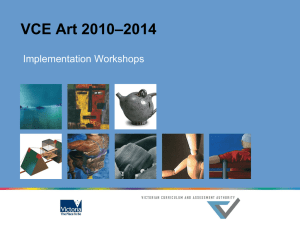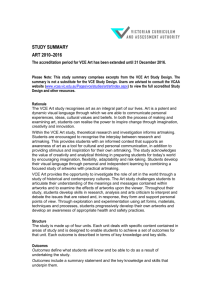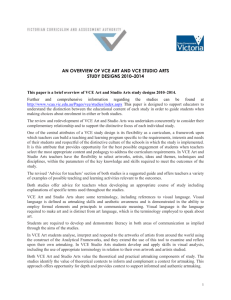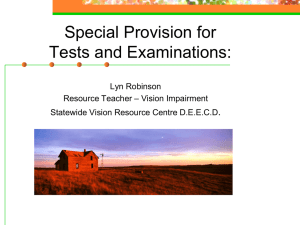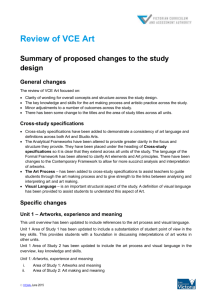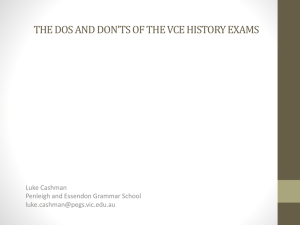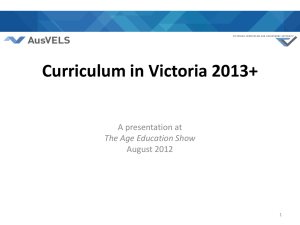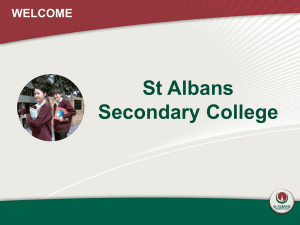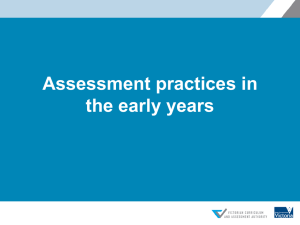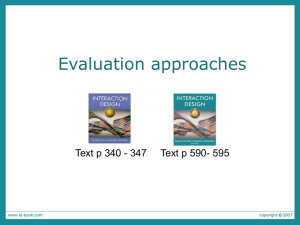VCE Art 2010–2014 - Victorian Curriculum and Assessment Authority
advertisement
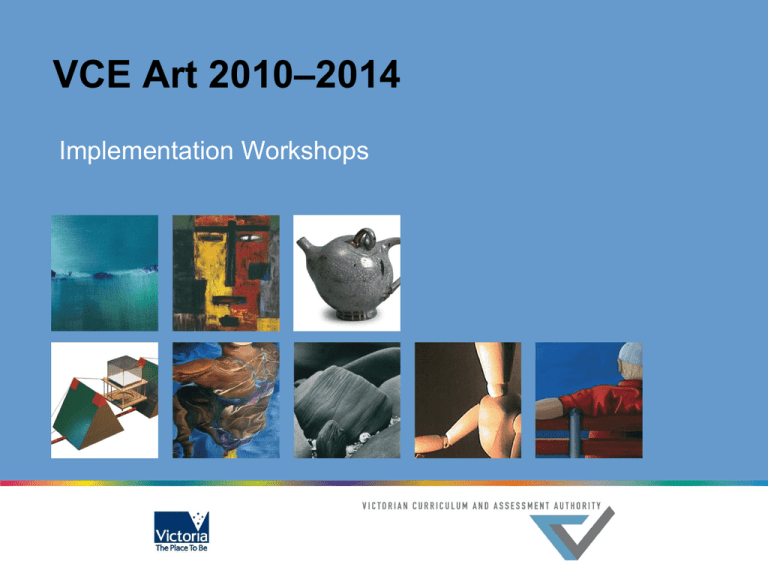
VCE Art 2010–2014 Implementation Workshops © Victorian Curriculum and Assessment Authority 2007 The copyright in this PowerPoint presentation is owned by the Victorian Curriculum and Assessment Authority or in the case of some materials, by third parties. No part may be reproduced by any process except in accordance with the provisions of the Copyright Act 1968 or with permission from the Copyright Officer at the Victorian Curriculum and Assessment Authority. VCE Art Implementation VCE Art Units 1–4 (2010–2014) Implementation Workshops 2009 VCE Art study design Teachers should thoroughly familiarise themselves with the Study Design including: • Introduction (p7) • Structure (p8) • Assessment and Reporting (p10) • Analytical Frameworks (p12–14) • Units 1-4 (p15–29) • Advice to Teachers (p30–58) Goals for the workshop • Introduce the reaccredited VCE Art Study Design (2010–2014) • Highlight the differences between the reaccredited study design and the current study design • Review draft assessment criteria for the School Assessed Task • Provide some time for discussion • Review gallery resources VCE Art study design (2010–2014) Rationale of the study makes explicit: • art as a tool for cultural and personal communication • the value of creativity and analysis in artmaking • that theoretical research supports practical artmaking • the value of understanding art of different cultures • the importance of discussing and debating art issues and ideas to develop informed viewpoints Advice to teachers section of the study design This section includes advice on: • Developing a course • Explanation of specific terms used throughout the Study Design • Progression of Analytical Frameworks • Theoretical Components of study • Visual Language • Student use of resource material • Learning activities Analytical Frameworks • The Analytical Frameworks include a series of questions that guide students and teachers in the analysis and interpretation of artworks • They are common to all Areas of study • Introduced in Units 1 and 2 • Fully implemented in Units 3 and 4 Analytical Frameworks There are four Analytical Frameworks • Formal – applied in Units 1–4 • Personal – applied in Units 1, 3, 4 • Cultural – applied in Units 2, 3, 4 • Contemporary – applied in Units 3, 4 Structure of the study The study is made up of four units with two areas of study in each unit In all areas of study theoretical outcomes now precede practical outcomes. Unit 1 • AoS 1 – Art and meaning • AoS 2 – Artmaking and personal meaning Unit 2 • AoS 1 – Art and culture • AoS 2 – Artmaking and cultural expression Structure of the study Unit 3 • AoS 1 – Interpreting art • AoS 2 – Investigation and interpretation through artmaking Unit 4 • AoS 1 – Discussing and debating art • AoS 2 – Realisation and resolution Structure of the study Key knowledge Provides content Key Skills Provides application For example: • generate ideas • select, create, organise • investigate • evaluate • analyse Unit 1 Area of study 1 – Art and meaning Outcome 1 Analyse and interpret a variety of artworks using the Formal Framework and the Personal Framework. • Emphasis is placed on the interpretation of artworks through visual language and the personal perspectives of the artist and viewer Unit 1 Area of study 2 – Artmaking and personal meaning Outcome 2 Present visual creative responses that demonstrate their personal interests and ideas through trialling techniques, materials and processes. • Emphasis is on providing a guided exploration for students when creating artworks through the application of the Formal and Personal Frameworks • Students are encouraged to explore and evaluate their own ideas through reflective annotation of their artmaking Unit 2 Area of study 1 – Art and culture Outcome 1 Analyse, interpret, compare and contrast artworks from different cultures using the Formal Framework and the Cultural Framework. • Focus is in on the ways in which art communicates the values, traditions and beliefs of societies Unit 2 Area of Study 2 – Artmaking and cultural expression Outcome 2 Demonstrate technical and artistic development in the presentation of visual responses that include one finished artwork, through the exploration of selected media, materials and techniques. • Emphasis is on the development of areas of personal interest related to cultural identification. • Students apply the Formal and Cultural Framework to reflect upon and annotate their artmaking Unit 3 Area of study 1 – Interpreting art Outcome 1 Use the Analytical Frameworks to analyse and interpret artworks produced before 1970 and artworks produced since 1970, and compare and contrast the meanings and messages of artworks produced before 1970 with those of artworks produced since 1970. • Emphasis is on students comparing and contrasting a variety of artworks and developing an interpretation of them • Students use a range of resources in their research and relevant aspects of all Analytical Frameworks Unit 3 Area of study 2 – Investigation and interpretation through artmaking Outcome 2 Explore personal ideas and concepts through a conceptual and practical investigation including at least one finished artwork, using selected Analytical Frameworks to reflect upon and annotate their work. • Students commence building a body of work that includes at least one finished artwork • The focus is on exploring ideas through a practical as well as conceptual investigation Unit 4 Area of study 1 – Discussing and debating art Outcome 1 Discuss and debate an art issue using selected artist/s works as context, and present their informed opinion with reference to artworks and with the support of selected commentaries and relevant aspects of the Analytical Frameworks. • A minimum of one artist must be studied and two artworks by that artist • New content focuses on discussing art issue/s • Students use commentaries that present different viewpoints to develop and substantiate their own point of view Unit 4 Area of study 2 – Realisation and resolution Outcome 2 Progressively communicated ideas, directions and/or personal concepts in a body of work that includes at least one finished artwork, having used selected Analytical Frameworks to underpin reflections on their artmaking. • Students continue to develop and resolve a body of work and produce at least one other finished artwork • It is expected that the body of work will show evolution and resolution of ideas and progressive development of skill • Students continue to apply relevant aspects of all Analytical Frameworks to support reflective annotation Questions School-assessed Task Small group discussion: 1. What questions might you ask when assessing work using this criteria? 2. What concerns might you have determining the achieved level of performance? SAT - A sample approach: Outcome 2 Criterion 4 Assessing the process development work and minimum of 2 finished artworks • • • How has the student used formal qualities, elements and principles to communicate concepts and ideas? Does the selection of formal qualities, elements and principles effectively communicate concepts and ideas? How has the student used aesthetics to support the communication of concepts and ideas? Assessing written annotation • • • How effectively has the student documented their insights and used visual language to communicate concepts and ideas? How effectively has the student evaluated the work? Is there evidence that the student has used all relevant aspects of the Analytical Frameworks? SAT - A sample approach: Outcome 2 Criterion 5 Assessing written annotation • What evidence is there that the student has used the Formal, Personal, Cultural and Contemporary frameworks? • To what degree are the references to the Analytical Frameworks appropriate to the student’s work? • Is there consistent evaluation and documentation of the development of ideas and artmaking processes? VCE Art assessment – Units 3 and 4 Schoolassessed coursework Unit 3 Outcome 1 Outcome 1 Study score total 10% Outcome 2 % of study score November exam 10% Outcome 2 Unit 4 Schoolassessed task 20% 50% 30% 100% Assessment advice Published annually in the VCAA Bulletin each February Submission and Audit of Unit 3 Coursework – August Visitation Review and Submission and Audit of Unit 4 Coursework – October Feedback on Visitation Review – December Professional development for teachers SAT information days held at VCAA assessment centre – Coburg Term 1 held annually, notification of dates published in the VCAA Bulletin and Memorandum to schools and online at the relevant study pages http://www.vcaa.vic.edu.au/vce/studies/art/artindex.html • Review folio work • Unpack Assessment criteria and apply to student folios To register contact Susan Meadows meadows.susan.s@edumail.vic.gov.au Ph: (03) 9225 2214 Application to be a reviewer SAT Review Visitation http://www.vcaa.vic.edu.au/vce/exams/vceassessor.html www.ssms.vic.edu.au General Enquiries – VCE Examinations Ph: (03) 9225 2349 National Gallery of Victoria NGV Schools Programs Learning in the Gallery Tailor Made Outreach VCE Programs Online Education Resources Resources and kits for download Symposium and conference papers Exhibition room brochures Online interactives Professional Learning Program Bookings www.ngv.vic.gov.au/ngvschools/ PH: 8620 2222 Gallery Contacts Horsham Fine Art Gallery Education Officer: Michael Shiell PH: 5362 2888 Email: Michael.shiell@hrcc.vic.gov.au www.horshamartgallery.com.au McClelland Gallery & Sculpture Park Education Officer: Silvia Krambeck PH: 9789 1671 Email: silvia.krambeck@mcclellandgallery.com www.mcclellandgallery.com Bendigo Art Gallery Education Officer: Helen Attril PH: 5434 6082 Email: h.atrill@bendigo.vic.gov.au www.bendigoartgallery.com.au Gippsland Art Gallery – Sale Education Officer: Simon Gregg PH: 5142 3372 Email: Simon.gregg@wellingtonvic.gov.au www.wellington.vic.gov.au/Page/page.asp?Page_ Id=1055&h=0 Geelong Art Gallery Education Officer: Susan Barlow PH: 5229 3645 Email: education@geelonggallery.org.au www.geelonggallery.org.au Bulletin online • The VCAA Bulletin VCE, VCAL and VET is now online • A free subscription is available at www.vcaa.vic.edu.au • Follow the prompts to the subscription page and enter your details • Ensure your email address is entered correctly With thanks to: Tricia McCormack Andrew Landrigan Coralie Buckley Art Education Victoria (AEV) Galleries and education staff of: Bendigo Art Gallery Geelong Art Gallery Gippsland Art Gallery Sale Horsham Fine Art Gallery McClelland Gallery and Sculpture Park National Gallery of Victoria Contact Details Victorian Curriculum and Assessment Authority (VCAA) Michele Davies Curriculum Manager, The Visual Arts Ph: (03) 9651 4451 Fax: (03) 9651 4324 Email: davies.michele.l@edumail.vic.gov.au www.vcaa.vic.edu.au
